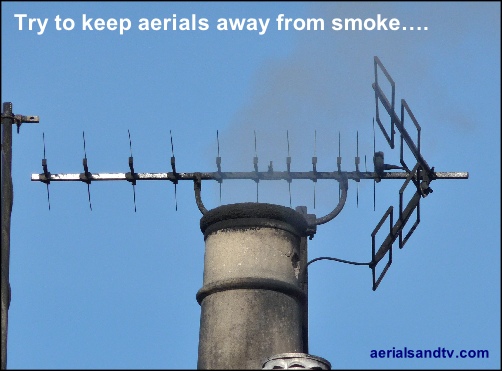Wall and chimney brackets
All about installing wall and chimney brackets.
Also see :
- Brackets and clamps
- Brackets/Galvanising tests
- Our pole and bracket lifetime warranty
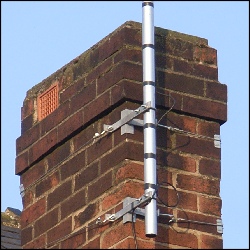
Subject list :
- Brackets basic info incl : check the required stand off exactly !
- Bracket dimensions : in a comparative table
- Standard wall brackets
- Varying quality of brackets
- Mini wall brackets
- “T & K” brackets incl : more wall anchors = stronger install
- Bracket spacing
- Low profile brackets
- Galvanising
- Tilting brackets
- Mounting aerials on fascias ?
- Wall or chimney bracket ?
- - - Keep aerials out of smoke and fumes !
- Summary of which bracket to use with which pole/aerial
Brackets - basic info
Brackets are classified according to their size (from the top pole clamp to the bottom one) and their "stand-off", that is to say the distance from the wall (or chimney) to the pole will be when it is "in-situ". The latter may be significant if the pole has to clear an overhang above it but bear in mind that these dimensions are to the end of the bracket, 3" to 4” will be "lost" in accounting for the width of the pole / clamps, see picture below. When working out the required stand off (or pole offset) you need to clear an overhang we strongly advise against estimating this ! Unless you are sure, get up there and measure it exactly because you’ll kick yourself if you end up with a bracket (and/or pole) with insufficient stand off......
Next add about 2” to this figure, it can be more, but that is just "wasted" stand off. This is to prevent high winds causing the pole to bang against the fascia (or gutter) and also to facilitate maintenance of the latter.
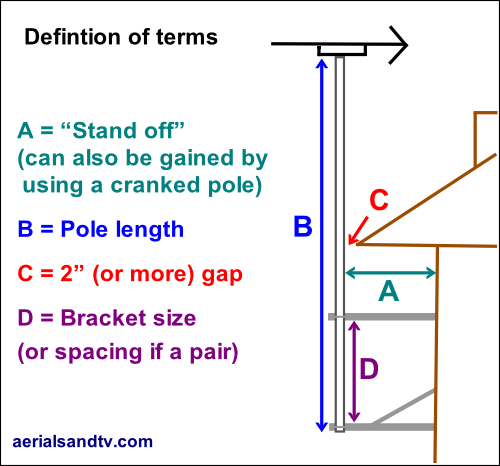
But always remember you don’t have to use a huge “stand off” bracket if you can use a cranked pole !
When installing a wall bracket always leave 2 to 4 courses of bricks above the install *, and try to make it 4 to 6 courses if installing the aerial at the top of a gable.
* Depending on the size of the aerial and the length of the pole, and whether you’re using a Black and Decker or an SDS hammer drill to drill the holes......
I would think the 6x6 and the 6x9 are what can be called the standard wall brackets. Having said that these are only called "standard brackets" for classification purposes, they are welded (and galvanised) and if use singly with short pole or in pairs with a long pole they are still worthy of the description "heavy duty".
To take the 6 x 9 bracket : as an example (illustrated below) the first dimension in a bracket size is relevant according to the length of the pole which the bracket is expected to support. A longer pole will generate more leverage on the bracket (and the wall.....) and therefore a bigger bracket should be used. The second dimension is the length to the end of the bracket and it is this which determines the stand off of the bracket (minus 4” to accommodate the V bolt slots" though ! ).
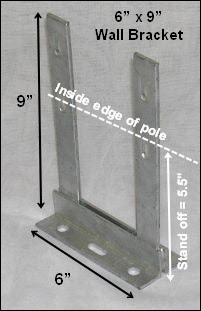
Bracket Dimensions
Also see each bracket's buy page which includes all the dimensions pictorially.
NOTE : we recommend a 2 inch gap between the pole and any overhang.
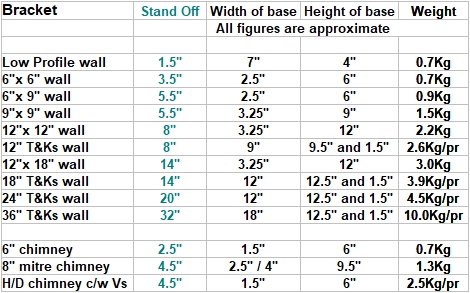
There are basically three main variants of the type of bracket used on many smaller installation jobs, that is to say the 6"x6" bracket (wall or chimney mount).
The cheapest type of the three is the pressed steel bracket. It is galvanised but it is of the “Pre-Galv” type. Although this is far preferable to just being painted, it will not remain rust free anywhere near as long as a "hot dip galvanised" bracket would. As the name implies it is just a bent piece of metal sheet (typical thickness 2.5mm) and it is not in the same class (strength wise) as a welded bracket (in fact they're so weak they can even be bent in imaginative ways) and most only take three wall anchors.
The next category up is the welded (but painted.....) bracket. These are significantly stronger than the pressed variety and are welded together out of steel angle/bar of typical thickness 3.0 to 5.5mm. Welded brackets are available in either painted or galvanised finish. Although there is no difference strength wise between them the difference in finish is chalk and cheese. A painted bracket can start rusting almost straight away and will often show significant surface rust within a few years. It must be admitted that it’d usually take decades for rust to significantly weaken a painted welded bracket, but it will do so eventually ! Thus, at the top of the tree, is the welded hot dip galvanised bracket, even damaged galvanising still doesn't rust. It will come as no surprise to learn we only stock those……
The picture shows a 6”x 6”, a 6”x 9”, and a heavy duty (angle section steel) 9”x 9” wall bracket. We also sell heavy duty wall brackets in 12x12 & 12x18.
All our brackets are of welded construction and “Hot Dipped” galvanised (to BS EN ISO 1461).
Note ! Remember to order the V Bolts (plated or stainless) with the brackets !
We also sell the wall anchors for our brackets.
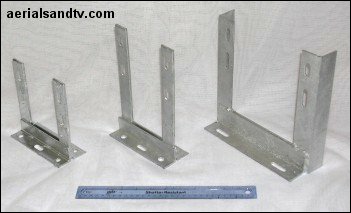
You never stop learning do you ?
I've been in this trade for 25 years but never knew that such a crap bracket could exist as that illustrated alongside.
In the first place it's painted (and therefore rusting) but far worse than that is how thin the arms for installing the pole on are, about 2mm..... Note how they are bending ! The arms on the 6x6 wall brackets we sell are just over 4mm thick and those on the 6x9 are just over 5mm.
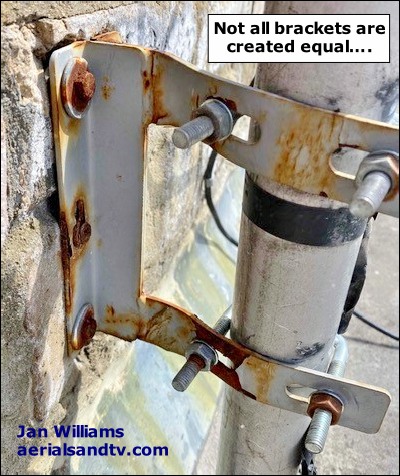
The picture illustrates the difference in construction standard between a pressed Chimney bracket and a welded type. Perhaps even more striking is the amount of rust on the “Pre-Galv” pressed bracket.
Note the “failed” steel pole, it departed this world due to rust.
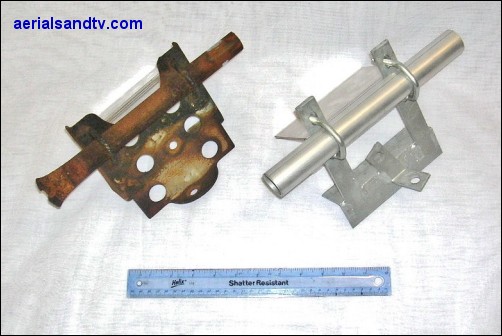
Mini wall bracket
A neat but strong bracket perfect for mounting an off the wall facing antenna (sold here).
All steel construction and hot dipped galvanised.
Pole 4 inches by 1.25 inch diameter.
Also see Through bracket
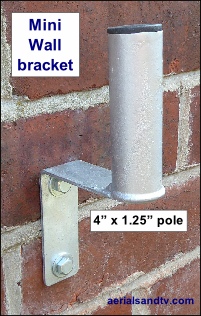
T&K wall brackets
These are the strongest wall brackets (even more so if using two Ks, see below) compared to any single bracket, provided the spacing is adequate. Sold here.
But do you really need T & K brackets, when cranked / Supercranked poles are available ? !
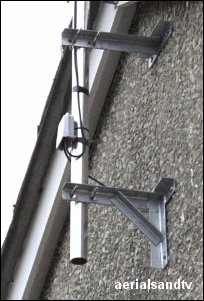
Here we have a pair of the smallest generally available T&Ks the 12", plus a pic of the largest, the 36". Note the additional diagonal bracing on the latter.
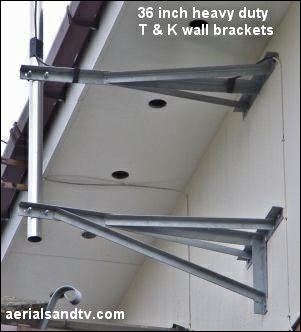
It must be stressed that T & Ks are used to gain more stand off (also see 12x12 & 12x18 heavy duty wall brackets), not because they’re stronger than a pair of smaller brackets, particularly if the latter are of the welded variety. So long as the pole’s V bolts will fit the bracket there is no reason why even two standard wall brackets (or low profile brackets) cannot be used for a long pole and/or large aerial. Quite apart from anything else a pair of smaller brackets will have eight wall anchors and four V bolts to secure the pole, as against only five anchors (though more can be fitted, see below) and two V bolts for a standard pair of T&Ks. Remember : more wall anchors = a stronger install (the wall anchors usually fail before the bracket) and this is particularly important when the forces are towards/away from the wall. Alternatively, if the wall material is suitable (hard and solid), use sleeve anchors.
“T”s and “K”s are available separately (here) and two “K”s are obviously a bit stronger than a T&K, though it must be admitted there are relatively few installations where this would be of consequence, after all, the pole would generally fail before the bracket anyway ! However, each “K” does take three wall anchors (in fact the “K”s we sell have a fourth hole just at the point the two base plates are welded together) whereas each “T” only takes two. This can be significant if there are loads of voids in the brickwork and some of the wall anchors won’t tighten…… Alternatively, if using a “T” with a long pole and/or large aerial, consideration should be given to drilling additional holes (they won’t rust if the bracket is hot dip galvanised) in the bracket’s baseplate to allow the use of additional anchors.
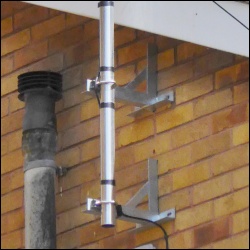
There are two opposing views as to which bracket (the T or the K) should go at the top. The K is obviously the more robust bracket and the received wisdom is that this should go at the bottom because, being further down, the wall is stronger there. However the top bracket is probably under the most stress (certainly if the wind is blowing the pole away from the wall) and so some think the K should go there instead ! Basically one has to work out the relative importance of the two factors for the particular install being undertaken. For an install at the peak of a gable I would put the K at the bottom, whereas on a strong flat top wall I’d put the K at the top. Basically it’s six of one, and half a dozen of the other, but, if in doubt, put the K at the bottom !
T & K brackets are designed to increase stand off but what about when less stand off is required ? ! ? For those applications use the Low Profile Bracket (sold here). These brackets accept poles from 1.25” to 2” / 56mm in diameter (for 1” poles use through brackets). The stand off is approximately 1.5 inches. They are supplied with a sledge and bolts so you don’t need to separately order a pair of V bolts. You would generally use them in pairs unless it’s a small aerial on a short (3ft or less) pole. Because the stand off is so small the brackets are actually very strong despite only being 1.5mm pressed steel.
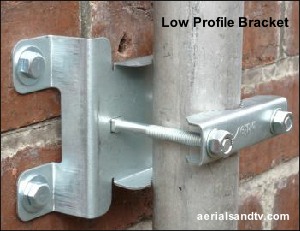
Note that low profile brackets don’t allow any adjustment of the poles stand off so should only be used on a flat surface.
Available in Pre galv with plated bolts or hot dip galv with stainless bolts.
Low profile brackets look very neat and if standoff is required this can be achieved by using a cranked pole.
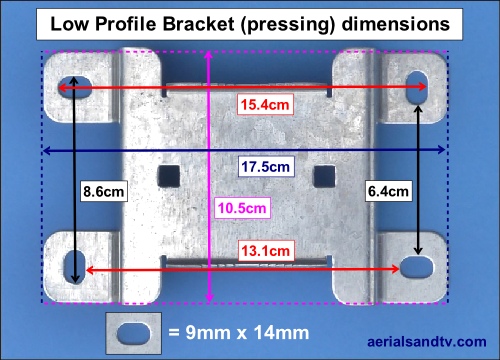
Obviously the spacing of any pair of brackets determines the strength of the installation and this varies according to the size of the aerial, the length of the pole and the likely winds to be encountered. For small aerials in sheltered locations I’d separate the brackets by at least 1” (top V bolt to bottom one) for every foot of pole, but for large aerials in exposed areas I’d at least double it to 2” per foot of pole. For Starlink I'd recommend about 2.5" per foot of pole. Larger satellite dishes may require 3”, 4” or even 5” separation per foot of pole, depending on the size and likely winds.
Poles which are guy wired do not require the brackets to be as widely spaced (1” per foot of pole ? ), which will have the side benefit of giving you a slightly longer pole (above the top bracket).
But remember that it is totally irrelevant how strong the bracket(s) are if the installer only uses two wall screws.....
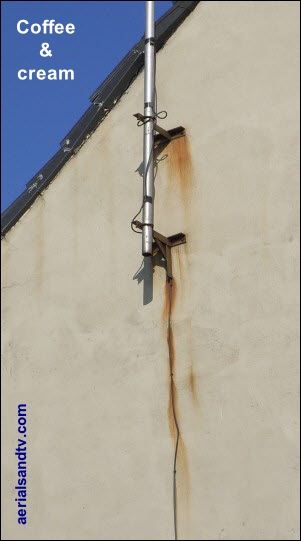
Coffee & Cream
Do you really want that on the front of your house ? ! ?
It isn’t uncommon to see rusting steel brackets fitted on the apex of rendered walls with huge rust stains stretching out beneath them.... All for the sake of a bit of decent galvanising. The latter is just what you get on a galvanised welded bracket and these are the only type we sell. None of your thin finish "Pre-Galv" here, this is "Hot Dipped" galvanising (ours are to BS EN ISO 1461) and it is very impressive. We’ve seen brackets that have been up 25 years plus without a trace of rust staining. In fact we’ve got some experiments running where we’ve actually tried to file off the galvanising finish (on a section of the brackets) and left them outside in the rain
Despite having damaged galvanising they haven’t rusted at all in over 15 years, that's FIFTEEN YEARS !
I really wonder how anyone, no matter how big a bodger they are, could possibly contemplate using a painted bracket. They must be tighter than a camel’s arse in a sandstorm.......
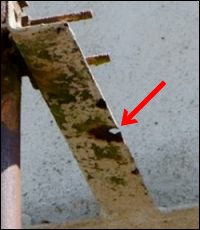
It must be admitted that in most locations and/or for most jobs galvanising is primarily about appearance, it would take years and years for rust to significantly affect the strength of the bracket, though a somewhat shorter time if you live by the sea ! BUT, as the adjacent picture on the shows, hot dip galvanising's superior rust prevention can also be about the long term strength of the install……
Not all galvanising is created equal....
These saddles have been in salt water for 2 years, the top one is hot dip galvanised, the bottom one is Pregalvanised.
Also see galvanising tests.
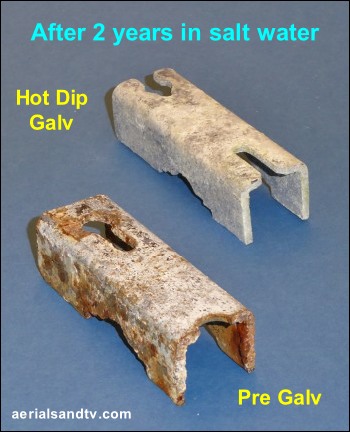
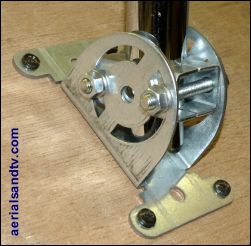
The tilting bracket (sold here) is specialised for, well, tilting. This product is very handy when you need to point your pole anything other than parallel with the wall (or whatever). This bracket is not intended for heavy duty applications (indeed it will only accept a 1 inch pole), but having said that it’s actually rather stronger than it looks !
The bracket will allow +/- 50deg (approx) of tilt from the perpendicular.
Note that there is an alternative to this bracket, an L Section loft kit, but insert the short of the L section into the side of the supplied two way bracket (see picture on the link). You can now rotate the pole to any angle +/-90 degrees.
Mounting brackets on fascias ?
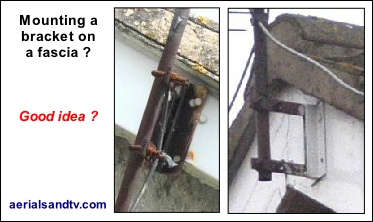
The simple answer is that it’s bad practice and it shouldn’t be done unless there is absolutely no alternative. A bracket mounted on a wall (with the appropriate pole to clear any overhang) is far stronger than just attaching it to a fascia or bargeboard. Furthermore screwing brackets to wooden boarding greatly increases the chances of rot setting in and makes it more awkward to repaint them as well. Finally, many people will eventually have UPVC replacement fascias fitted, and then the bracket will need moving anyway.
I don’t even want to think about anyone actually screwing an aerial to a UPVC fascia.........
Wall or Chimney Bracket ?
The crucial difference between a wall bracket and a chimney bracket is that the former is screwed to the wall whereas the latter is lashed to it, in fact they are sometimes referred to as lashing brackets. It is vital that this difference is appreciated because the main reason that anything bolted to a wall has any strength is the bulk of the brickwork above (and around) that to which it is actually screwed. Unless a chimney is of large proportions it is unlikely that there will be sufficient bulk/weight in it for a screwed fixing to be adequate. The answer is to use a lashing wire to tightly hold the bracket onto the corner of the chimney. For the same reason mentioned above, there should be a few courses of brick left above the installation. J-bolts are used to provide the required tension, though the lashing kits we stock use a pre-terminated eye-bolt on one of the ends so as to simplify/speed up the install. We supply an instruction sheet with the lash kits we sell, alternatively see here.
If you really do have no alternative but to use wall brackets on a chimney : spread the brackets as far apart as possible for extra strength, keep the pole as short as possible, and consider using an extra bracket to spread the load over more bricks.
Shared chimney ? What to tell an awkward neighbour……
Also see using a chimney bracket to mount an install on the corner of a masonry (or steel) structure.
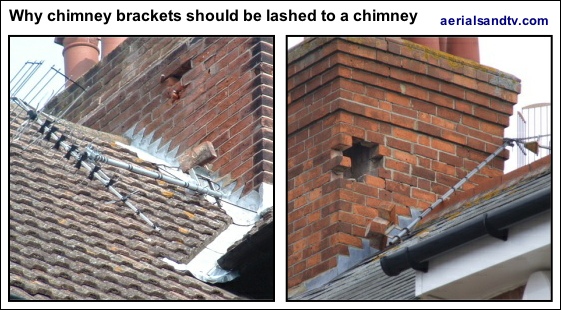
When it’s called a wall bracket, that’s for a reason. They’re not meant for chimneys. That would be a, what do they call it ? Ahh yes, a chimney bracket....... (pictures courtesy of Vision)
Some installers fit “Self Supporting Brackets” (sometimes called “Bang Bangs”) which do not utilise a lashing wire. They have two “L“ shaped pieces of metal which are hammered into the mortar between the bricks, hence the term “Bang Bangs”. Unless access problems are severe (and two are utilised to increase the support) most riggers know they’re a bodge because the strength of the install depends on the mortar around just two bricks at the corner of the stack.
Bertie Bodger's “Bang Bang” Bracket
Note how the masonry has been pulled out, and that’s out of a wall, not a (weaker) chimney stack......
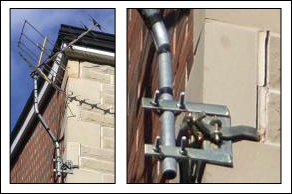
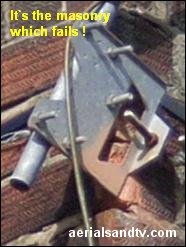
For aerial poles up to 3ft supporting small or medium size antennas we recommend and stock the 6”x 6” bracket. It is important to stress that a 6” welded bracket won’t “fail”, it’s the masonry which will go first, because a 6” bracket only spreads the load across the corners of two bricks, see adjacent picture [link]
For other installations using poles up to 8ft and aerials up to the size of an XB10 we sell the 8” mitre bracket. If an XB16 is fitted with an 8” mitre we’d go up to a 6ft pole. An 8” mitre usually covers three bricks and to a greater “depth”, see picture below left. The mitre bracket should also be used if your brickwork is in poor condition.
Unless the aerial is small poles of over 8ft usually require a pair of brackets.
See bracket to pole recommendations
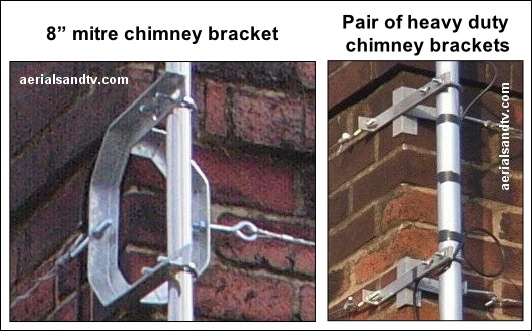
An 8 inch mitre chimney bracket in use. Note that the load imposed by the installation are spread over three courses of bricks and to a greater depth than simpler types of chimney bracket, compare to 6” bracket install above. Note the pre-terminated lash wire (see below).
Pair of Heavy Duty Chimney Brackets. These are exceptionally strong but must be used as a pair with two lashing wires.
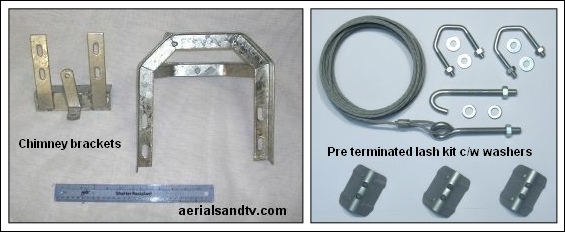
Here we have a 6”x 6” and 8”x 8”(mitre) chimney bracket, and the contents of a “Lashing Kit”. The latter includes 5m of pre-terminated wire, 2 x 1.5” V bolts and 6 plated washers (4 x M8 + 2 x M10).
If your chimney is bigger than 5m we stock a 10m length of the 7 strand galvanised lashing wire. This can be either used instead of the supplied length or used to extend it . Note that using long lash wires (or extra joins) increases the chances it won’t tighten up, so pull it as tight as possible (round the chimney) whilst making up the lash. Incidentally, do not confuse lash wire with thinner catenary wire, 7 strand lash wire is approx 3.7mm in diameter and weighs about 65g per metre.
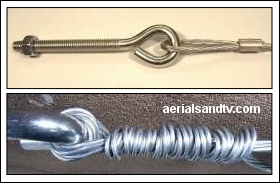
Close Up of lash wire terminations
Above is a “pre-terminated” end, our stock lash kits come with one end like this. The one below is made up by the installer, with the lash wire at the correct length to fit round the chimney and hold the bracket tightly on the side of the stack.
Summary of which bracket to use with which pole / aerial
It is good practice to follow these recommendations, in addition they must be followed to qualify for the lifetime warranty on our brackets.
Small aerials (particularly small collinears like Helium antennas) put much less wind load on the pole and brackets and in some cases the pole may actually have a higher wind loading than the aerial ! On the other hand larger aerials XB10s and even more so XB16s have much higher wind load, and satellite dishes higher still.
Satellite installs = up to 60cm and Starlink.
A 3ft pole can utilise a 6” welded wall bracket (6 x 6” or 6 x 9”) for all but the very biggest aerials like an XB16B, for one of those I'd use a 9"x9" wall bracket. If mounting on a chimney an aerial up to the size of our Yagi18 or XB10 can utilise a 6” bracket but an XB16 should use an 8” mitre, to be on the safe side.
Satellite / Starlink installs with a 3ft pole = a 9"x9" wall bracket or an 8" mitre chimney bracket.
A 6ft pole can be used with a 6” welded wall bracket for any aerial up to a Yagi18 though a 9"x9" is preferable. As always, one must make sure the wall anchors are tight. For larger aerials we would use a 9”x 9” wall bracket especially in exposed locations. Since cranked poles put a bit more strain on the bracket it may be advisable to go for a 9”x 9” bracket with a crank, and definitely so if fitting a Supercrank pole.
An 8” mitre chimney bracket should be suitable for all of our antennas on a 6ft pole.
Satellite / Starlink installs with a 6ft pole = a 12"x12" wall bracket, or T&Ks or a pair of "Low profile brackets", or a pair of chimney brackets (spaced at least 12" apart).
An 8ft or 10ft pole should be suitable for use with a 9 x 9” wall bracket on any aerial, apart from an XB16, provided the wall anchors are tight or sleeve anchors are used. I would probably advise the use of two brackets (or a 12x12 bracket or a pr of T&Ks) with an XB16, particularly in exposed locations
An 8” mitre chimney bracket would be suitable for a small aerial (e.g. our DM log periodic) but anything larger should use a pair of chimney brackets. These would usually (but not necessarily) be the pair of H/D type brackets spaced at about 12”, or more for an XB16 antenna.
I would be wary of fitting a pole of 10ft on a small chimney with any size of brackets particularly with a large aerial.
Satellite / Starlink installs with an 8ft pole = A pair of T&Ks or "Low profile brackets", or a pair of chimney brackets (spaced at about 2.5 inches per foot of pole).
A 12ft (or longer) pole on a wall requires a pair of brackets (often T & Ks, but not necessarily) or possibly a 12x12 bracket for the 12ft pole (the latter not for an XB16 or at very exposed locations). For XB16s a pair of brackets should be used, and be at least 18” apart.
For chimney mounting a pair of lash kits and two brackets should be used. The latter would usually, but not necessarily, be the H/D type. The spacing should be at least 20” (or 30” for a large aerial) for a 16ft pole and I would be even more wary fitting it on a small chimney ! It should be pointed out that it is very rare to have to fit a 16ft pole on a chimney.
Satellite / Starlink installs with a 12ft pole = A pair of T&Ks or "Low profile brackets", or a pair of chimney brackets (spaced at about 2.5 inches per foot of pole).
Lastly, if mounting an aerial on a chimney which is being used, or ever likely to be used, I’d recommend a cranked pole to try and get the aerial as far away from any smoke / fumes as possible. The smoke won’t affect the signal, but it isn’t good for the aerial * so I’d also place the antenna on the upwind side (of the prevailing winds, usually from the S or SW in the UK) if at all possible. Bear in mind that a smaller end mounted aerial (like a Yagi10K) can sometimes be mounted below the height of the chimney pots.
* not so much directly but by encouraging corrosion with all that pollution mixed with rain water.
